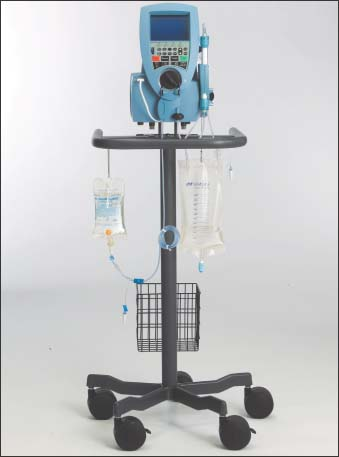Aquapheresis
Aquapheresis is a therapy that uses ultrafiltration to remove fluid from the blood. It provides an alternative method for relieving congestion caused by fluid overload in patients with decompensated heart failure who are resistant to diuretics.1
Aquapheresis is provided using venovenous access and a device known as the Aquadex FlexFlow ultrafiltration system (as shown at right on top). This device mechanically withdraws blood through a catheter and passes it through a hemofilter, which removes excess sodium and water, restoring fluid balance. After the patient’s blood is filtered, it’s returned to the patient through the infusion port of the catheter.
 |
Nursing Alert
Only individuals who have received specialized training in administering aquapheresis therapy are permitted to administer the therapy.2
Equipment
Aquadex FlexFlow pump ▪ sterile, disposable, single-use extracorporeal blood circuit set ▪ IV heparin bolus ▪ heparin infusion ▪ 500-mL IV bag of normal saline solution ▪ 10-mL syringes ▪ graduated liquid waste receptacle ▪ gloves ▪ sterile end caps ▪ alcohol pads ▪ venovenous access device (a 6 French dual-lumen extended-length peripheral catheter, a 5 French single-lumen extended-length peripheral catheter, and an 18G IV catheter, or a 7 or 8 French dual-lumen central venous access catheter).
Preparation of Equipment
Before therapy is initiated, the doctor or specially trained nurse will insert a venovenous access device. The catheter must be able to accommodate a blood flow of 10 to 40 mL/minute.
Implementation
Verify the doctor’s order for aquapheresis in the patient’s medical record, and make sure that diuretic and electrolyte replacement therapy has been discontinued before initiating therapy.
Make sure that preprocedure laboratory test results are available and documented in the patient’s medical record; report any abnormalities.
Make sure that informed consent has been obtained and is documented in the patient’s medical record.5
Confirm the patient’s identity using at least two patient identifiers, according to your facility’s policy.8
Explain the procedure to the patient to allay his fears and promote cooperation.
Obtain the patient’s weight.
Begin anticoagulant therapy at least 30 minutes before the procedure, as ordered, following safe medication administration practices. Typically an IV bolus dose of heparin is given, followed by a continuous heparin infusion.
Double-Checking High-Alert Medications10
When administering high-alert medications such as heparin, another nurse must perform an independent double-check of your preparation of the drug to ensure safe administration. The second nurse must perform the following tasks:
Verify the patient’s identity.
Make sure that the correct medication is hanging and in the prescribed concentration.
Ensure that the medication’s indication corresponds with the patient’s diagnosis.
Verify that the dosage calculations are correct and the dosing formula used to derive the final dose is correct.
Verify that the route of administration is safe and appropriate for the patient.
Ensure that pump settings are correct and that the infusion line is attached to the correct port.
Nursing Alert
When administered IV, heparin is considered a high-alert medication because it can cause significant patient harm when used in error. Another nurse must double-check certain preparation steps to ensure safe medication administration.9
Before starting the heparin infusion, have another nurse perform an independent double-check according to your facility’s policy. (See Double-checking high-alert medications.)
After comparing results of the independent double-check with the other nurse, begin infusing the heparin (through the withdrawal port of the access device) if there are no discrepancies. If discrepancies exist, rectify them before beginning the infusion.10
Verify patency of the access catheter.
Priming the Blood Circuit
Plug the power cord into a grounded electrical outlet.
Press the ON/OFF key on the front panel. (See A look at the aquapheresis circuit.)
Place the blood pump cartridge into the blood pump on the machine console and snap it into place. Turn the knob clockwise until you hear a beep.
Insert the ultrafiltrate cartridge in the side of the console and snap it into place. Turn the knob clockwise until you hear a beep.
Insert the tubing into the blood leak and air sensors.
Put the pressure sensor cables into their proper connectors, located on the console.
Stay updated, free articles. Join our Telegram channel

Full access? Get Clinical Tree


Get Clinical Tree app for offline access
